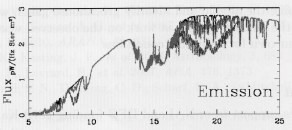
|
Molecular astrophysics books
|

|
Molecular astrophysics books
|

Dozens of different molecules have been discovered in space, including carbon monoxide, methane, water, ethyl alcohol, acetylene, formaldehyde, fullerenes, and polycyclic aromatic hydrocarbons (PAHs). It would be an exaggeration, though, to call space a seething cauldron. Many of these molecules spend their time floating around in space doing practically nothing. In the cold darkness of interstellar space, the high point in a typical molecule's life might be the day it changed from rotating once every ten years to once every five years. But in molecular clouds, like Barnard 68, there's a whole lot more exciting, rotating, and vibrating going on. There are even a few molecules on the Sun, in sunspots, where temperatures are cool enough for molecules to exist.
Even supernovas, the authors say, create molecules. Within 3 months after a Type II supernova explosion, nearly ⅓ of the mass ejecta has turned into molecules such as CO and SiO, while very few molecules containing hydrogen are created. That is surprising, because the most common molecule in the galaxy is dihydrogen (H2). This molecule is created not in stars but on the surface of interstellar dust grains, which act as a catalyst.
Because molecular clouds absorb ultraviolet light, their composition on the outside is different from that in the interior. Cosmic rays and X-rays penetrate much deeper and lead to rich free-radical chemistry inside a cloud that is similar to that produced by radioactive materials on Earth.
What can we learn from molecular astronomy? It can help us identify star-forming regions, most of which are found in Giant Molecular Clouds, so they're obscured by interstellar dust and hard to find. It can also tell us about cosmic ray flux and dynamic events like shock waves. In the future, we will rely on molecular astronomy to identify habitable extrasolar planets.
But the question of which wavelength is appropriate to measure turns out to be surprisingly difficult. The reactions are highly temperature- and pressure-dependent. Collisional de-excitation at high density can render even CO undetectable. High temperatures deplete H2 and create atomic hydrogen, which rapidly chews up other molecules. Accordingly, Williams and Viti barely mention any wavelengths, and there are no spectra at all in this book. Readers, they say, should consult the Leiden Atomic and Molecular Database.
Surprisingly there's not much actual chemistry here, either. There are also no descriptions of observational techniques. Among astronomers the term “observational” is used to contrast with “theoretical,” so the authors stuck all the equations in the last two chapters without deriving them.
So what we have here is a chemistry book that covers almost no chemistry, which discusses electronic transitions without showing any line spectra, and discusses observations while barely describing the instrumentation. It's just a basic introduction understandable by anyone with an interest in chemistry. You won't learn how to collect or interpret data. At the end of every chapter it tells you to go off and read Bruce Draine or Rybicki. Yet somehow it still manages to be fascinating and informative. As Darth Vader would say: Hmmm.
oct 12, 2014

This is a collection of 38 scientific articles on chemistry in space. Sections include Star Formation, Circumstellar Disks, Diffuse Clouds and Photodissociation Regions, Evolved Stars, Solar System and Extrasolar Planets, Extragalactic Chemistry, Basic Molecular Processes, and Tools of Analysis.
Most of the papers discuss how X-rays, UV, and other phenomena in the interstellar medium interact to produce chemical reactions. The most common carbon compounds in space are carbon monoxide and polycyclic aromatic hydrocarbons, but there is also formaldehyde, formic acid, ammonia, methane, cyanide—over 160 in all. The authors say that in carbonaceous meteorites, there are >46,000 different soluble compounds, with average composition of C100H155N3O20S3. PAHs are not just fused aromatic rings as we were led to believe, but show an incredibly complex chemical structure with aromatic and aliphatic regions. These molecules are highly enriched in deuterium compared to molecules on Earth.
Unlike Observational Molecular Astronomy (reviewed at left), there's lots of observational molecular astronomy here and lots of chemistry and spectroscopy as well. The authors are evenly divided between using infrared and microwaves. Some are also heavily into mathematical modeling to explain the observed abundances.

This is a tough book to read because sentences are crammed full of long strings of literature citations in “Author et al., Year” format. The articles are too short to give much detail, they're full of typos, the writing style is awful, and there's lots of overlap and repetition among the articles. Many of the figures were reduced from color to grayscale, making all the lines the same shade of gray and thus indistinguishable (see example above). So it's a typical scientific book. Welcome to my world.
Just to give one example, the graph comparing the abundance of NH2CHO, HCOOH, HCOOCH3, CH3OH, CO, and H2O in comets and hot cores on page 15 is identical to the one on page 270. Both are cited correctly, but there was obviously little editorial oversight. So I wouldn't recommend trying to read this one unless you're someone who has a burning desire to know the latest results in molecular astrochemistry. Which is everybody, right?
nov 30, 2014

Alexander Dalgarno is regarded as the father of molecular astrophysics. As of 2014, he's still alive, but he didn't contribute to this book. It's not even clear whether they invited him to this conference which was held in his honor. This was undoubtedly a fine book when it was published way back in 1990, but Cambridge University Press re-printed it as a paperback and gave it a 2005 publication date. Seems dishonest to me, but caveat emptor. The information here is hopelessly out of date.
Disclaimer: I did not read this book in its entirety.
oct 21, 2014